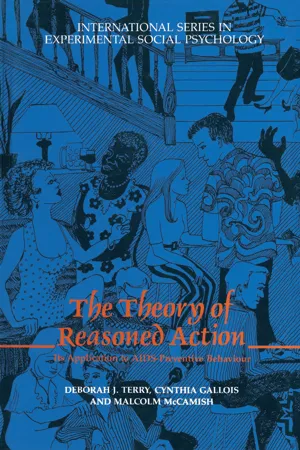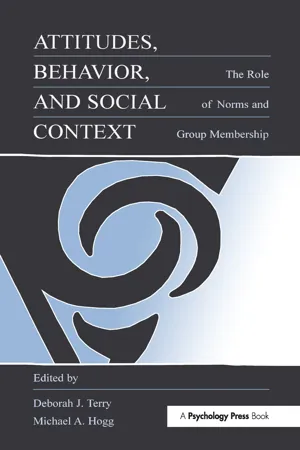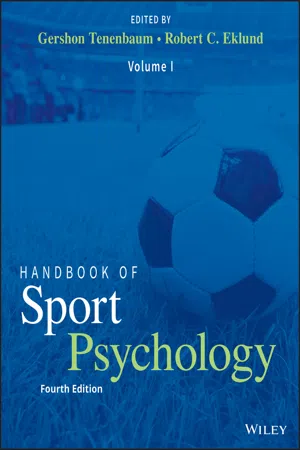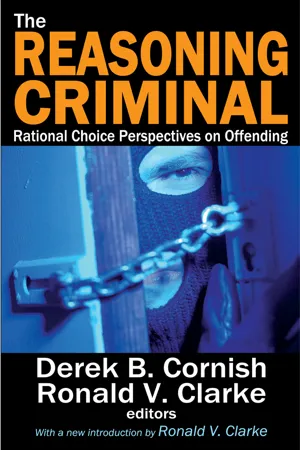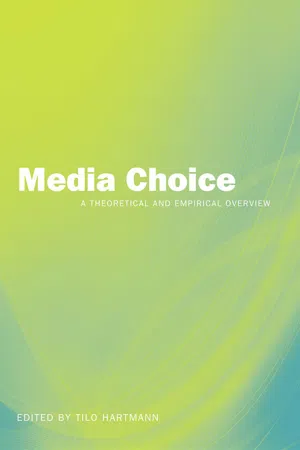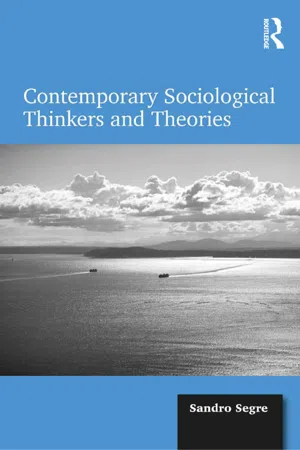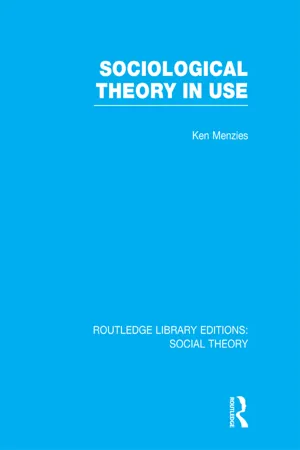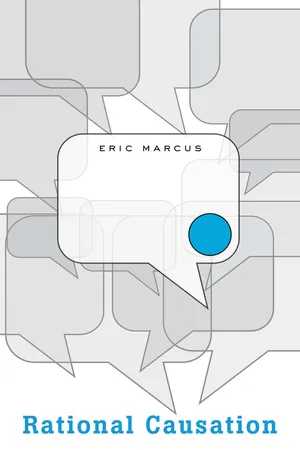Psychology
Theory of Reasoned Action
The Theory of Reasoned Action is a psychological model that explains and predicts human behavior based on an individual's attitudes, beliefs, and intentions. It suggests that people are more likely to engage in a behavior if they have a positive attitude toward it and if they believe that others important to them also support the behavior.
Written by Perlego with AI-assistance
Related key terms
Related key terms
1 of 4
Related key terms
1 of 3
10 Key excerpts on "Theory of Reasoned Action"
- Matthew Ikuabe, Clinton Aigbavboa, Chimay J Anumba, Ayodeji Oke(Authors)
- 2023(Publication Date)
- Routledge(Publisher)
Figure 5.1 ). People’s interpretation of their behavioural position influences their perception of their environment and thereby the inherent factors, which predict or alter the ensuing behaviour. This serves as the basis of the idea of reciprocal determinism by Bandura (ibid.). This takes into consideration the following: individual features in the context of biological events, cognition, and effect; behaviour; and environmental conditions that engender communication that leads to triadic reciprocity.Figure 5.1 Social Cognitive TheorySource: Bandura (1986).Theory of Reasoned Action (TRA)
The Theory of Reasoned Action (TRA), a multi-lateral behavioural theory, was propounded in 1980 by Ajzen and Fishbein (Chau and Hu, 2002 ). The model forms the backbone for studies related to the relationship between attitude and behaviour. Magee (2002) affirms that the theory has been deployed in various fields and is commonly deployed in the academic and business spheres. TRA postulates that an individual’s beliefs influence their attitude and social norms, which results in adopting certain behaviours or perhaps guiding the behaviour of the individual (Ajzen and Fishbein, 1980 ; Leach et al., 1994 ). The antecedent of behaviour is an intention, which is the cognitive portrayal of an individual’s willingness to act on a particular behaviour. TRA is founded on two constructs: (1) the attitude towards behaviour (ATB), and (2) the subjective norm (SN) in collaboration with that behaviour, as presented in Figure 5.2. The attitude towards the behaviour (ATB) serves as the prior attitude of an individual concerning the behaviour. People think about the decisions and possible eventualities of actions taken before taking such decisions. This theory refers to the view that a person’s intention to decide on taking action or not is based on the determinant of the action. In contrast, the individual’s beliefs and appraisal of the outcome determine the attitude. Subjective norm (SN) refers to the social pressure faced by an individual or what the decision-maker encounters to undertake the said behaviour. Leach et al. (1994)- eBook - ePub
The Theory of Reasoned Action
Its application to AIDS-Preventive Behaviour
- Cynthia Gallois, Malcolm McCamish, Deborah J Terry(Authors)
- 2015(Publication Date)
- Routledge(Publisher)
In considering TRA, it is important to find a balance between the adequacy of prediction and explanation on the one hand, and parsimony and simplicity on the other. The literature reveals a number of new variables and new relationships among variables that are proposed to improve the predictive power of TRA. The metatheoretical criticisms are also focused on widening the range of prediction and explanation of TRA. The theory of planned behaviour has already extended the range of prediction of TRA, and we must now ask whether new variables and relationships add sufficiently to have practical value. For the case of safer sex, this question can be answered in part by looking at the kind of activity safer sex is, and the particular factors that are important in safer sexual behaviours.Theoretical Issues
The Theory of Reasoned Action includes the concepts of beliefs, attitudes, subjective norms, intentions, and behaviour as its major components. Fishbein and Ajzen (1975 ; Ajzen & Fishbein, 1980 ) argued that these variables were necessary and sufficient to predict behaviours under the volitional control of actors. Despite the intuitive appeal of the theory, the past decade or so has seen a number of questions raised. These have included the adequacy of the conceptualisation of attitude, the measurement of the belief-based determinants of attitude and their relation to the direct measure, and the best way to determine which beliefs are salient to behaviour. In addition, the capacity of subjective norm to capture all the important normative influences on intention has been challenged, and additional normative variables have been proposed. Interactions between attitude and norm in predicting intention have also been posited. Finally, intention, its predictors, and its relation to behaviour have been questioned. We will examine each of these concepts in the context of research on safer sex and HIV-preventive behaviour.Attitude
The Theory of Reasoned Action adopts an expectancy-value (EV) model of attitude. The EV model claims that attitude is determined by expectations about the object, which are evaluated as positive or negative. The attitude, then, is some function of the expectations and their associated values (e.g., see Bagozzi, 1984 , 1985 ; Feather, 1982 ). In TRA, this formulation can be seen in the belief-based measure of attitude, where be havioural beliefs (e.g., the perceived likelihood of various outcomes of using condoms for sexual intercourse) are multiplied by the evaluation of each outcome (see Terry et al., - eBook - ePub
Attitudes, Behavior, and Social Context
The Role of Norms and Group Membership
- Deborah J. Terry, Michael A. Hogg(Authors)
- 1999(Publication Date)
- Psychology Press(Publisher)
4 A Theory of Attitudes, Subjective Norms, and Private Versus Collective Self-ConceptsDavid Trafimow New Mexico State UniversityOne of the most important tasks for personality and social psychologists is to predict behavior. Consequently, several theories have been proposed for this purpose. One theory that has performed well over the last few decades is Fishbein’s Theory of Reasoned Action (TRA; Ajzen & Fishbein, 1980; Fishbein, 1967b; 1980; Fishbein & Ajzen, 1975). According to this theory, the proximal cause of behavior is intention to behave, which, in turn, is caused by attitude and subjective norm. An attitude is the target person’s opinion about whether the behavior is positive or negative, and a subjective norm is the target person’s opinion about what most others who are important to him or her think he or she should do. Attitudes and subjective norms are determined by beliefs about the consequences of the behavior and beliefs about the opinions of specific important others, respectively.Not surprisingly, recent investigators have added other variables to the model. Some of these are affect (Triandis, 1980), perceived behavioral control (Ajzen, 1988), moral values (Gorsuch & Ortberg, 1983), previous behavior (Bentler & Speckart, 1981; Fredricks & Dossett, 1983), behavioral norms (Grube, Morgan, & McGree, 1986), and habit (Triandis, 1980). Although each of these variables has been shown to increase our understanding of some behaviors, attitudes and subjective norms have remained central components of the theories, and much of my own research has been concerned with them. This chapter summarizes that work by placing it in a context of some propositions that specify the relations between attitudes, subjective norms, and private and collective self-concepts (see Table 4.1 ).The propositions are presented in an order that, like the TRA (Fishbein, 1980), traces behavior back to other variables. The first proposition takes into account recent research suggesting that behavioral intentions are not the only proximal determinant of behavior. The second proposition addresses whether attitudes and subjective norms, the presumed determinants of intentional behavior, are really separable from each other. The third proposition suggests that the distinction between attitudes and subjective norms can be applied to people as well as behaviors. Furthermore, five subpropositions suggest variables that influence the extent to which people or behaviors are controlled by attitudes and subjective norms. These include the private self, the collective self, and culture. Finally, the fourth and fifth propositions propose distinctions between different types of beliefs that - eBook - ePub
- Gershon Tenenbaum, Robert C. Eklund, Gershon Tenenbaum, Robert C. Eklund(Authors)
- 2020(Publication Date)
- Wiley(Publisher)
1 Theory of Planned BehaviorMark ConnerUniversity of Leeds, Leeds, United KingdomTheory Overview
The theory of planned behavior (TPB) (Ajzen 1985 , 1988 , 1991 ) is a widely used theory of the proximal determinants of behavior. By the end of 2017, the key Ajzen (1991 ) paper on the TPB had received over 54k citations on Google Scholar. It has been widely applied in relation to a range of behaviors including predicting physical activity and sport participation as evidenced by several meta‐analyses in this area (Downs & Hausenblas, 2005 ; Hagger, Chatzisarantis, & Biddle, 2002 ; Hausenblas, Carron, & Mack, 1997 ). The theory should be seen within the context of an evolving set of related theories that includes the earlier Theory of Reasoned Action (TRA) (Ajzen & Fishbein, 1980 ; Fishbein & Ajzen, 1975 ) and the later Reasoned Action Approach (RAA) (Fishbein & Ajzen, 2010 ). These theories each emphasize the deliberative processing of available information in the formation of intentions. This chapter, first, provides a description of these three related theories and the correlational and experimental evidence supporting them, second, critiques aspects of the theory, and third, reviews potential additions to the theories and moderators of relationships among theory components.Theory of Reasoned Action and Planned Behavior
The TRA, TPB, and RAA all suggest that the key proximal determinant of action/behavior is one’s behavioral intention to engage in that behavior. Behavioral intention represents a person’s motivation in the sense of her or his conscious plan, decision, or self‐instruction to exert effort to perform the target behavior. These are usually tapped by items assessing likelihood of intending to perform the behavior (Ajzen, 2002a ; Conner & Sparks, 2015 ). In the TRA, behavioral intentions are determined by attitudes toward the behavior and subjective norms. Attitudes are the overall evaluations of the behavior by the individual. Fishbein and Ajzen (1975 , p. 6) define an attitude as “a learned disposition to respond in a consistently favorable or unfavorable manner with respect to a given object.” Attitudes are usually tapped using semantic differential measures (Ajzen, 2002a ; Conner & Sparks, 2015 ). Subjective norms consist of a person’s beliefs about whether important others think he/she should engage in the behavior. Subjective norms are assumed to assess the “social pressures” (from salient referents) that individuals feel to perform or not perform a particular behavior. Subjective norm is usually tapped items assessing the approval of important others for the individual performing the behavior (Ajzen, 2002a ; Conner & Sparks, 2015 - eBook - ePub
The Reasoning Criminal
Rational Choice Perspectives on Offending
- Marvin Scott(Author)
- 2017(Publication Date)
- Routledge(Publisher)
At this level of description, the theory may appear banal. All it is saying is that whether a person intends to do something or not depends on whether that person likes (or dislikes) the idea of his doing it (the attitude to the act) and whether he thinks he should do it (the subjective norm). The power of the theory arises from the precise measurement methods proposed for these two variables and from its capacity to "unpack" each particular variable in terms of the underlying beliefs. Thus, attitudes are held to be dependent on beliefs about outcomes (both what the actor expects will happen and how he or she evaluates these possibilities), and norms are seen to be dependent on the expectations of salient others.More formally, behavior (B , any conscious action) is preceded by a behavioral intention, and this behavioral intention (BI) is itself a result of two and only two measurable variables: the attitude to the behavior (A act ) involved (not the attitude to the object with which the behavior is concerned but the attitude to the act or behavior itself) and the individual's subjective norm (SN) concerning the act. The term subjective norm refers to perceptions that most important others think the person should or should not engage in the act. The weighting of subjective norms and attitudes in the formation of behavioral intentions is held to vary both across individuals and across acts in ways that can be determined empirically. This theory is expressed in the regression equation:B ( − B I ) =A+ S N .a c tThere is a large literature in which this equation has been applied and found to hold (see Ajzen and Fishbein, 1980). With appropriate measurement the equation is robust. The behavioral theory is supplemented by a theory of attitudes based on beliefs and evaluations that can be stated formally in the equation: - eBook - ePub
Media Choice
A Theoretical and Empirical Overview
- Tilo Hartmann(Author)
- 2009(Publication Date)
- Routledge(Publisher)
Action Theory, Theory of Planned Behavior and Media Choice Tilo HartmannAction theory regards people as decision-makers who follow intentions and voluntarily pursue their goals (Eccles & Wigfield, 2002). According to this theory, people may be affected by environmental and inner pressures and affordances, but ultimately behavior is guided by reflective, higher-order cognitive processes (Smith & DeCoster, 2000; Westerick, Renckstorf, Lammers, & Wester, 2006). People’s higher-order cognitive processing responds to immediate “forces” such as internal drives or external pressures, but is not considered to be fully determined by them. Accordingly, action theory underlines the capability of people to cognitively ponder their environment and to run projections regarding various outcomes before they choose an option and undertake an action. A full explanation of media choice from the perspective of action theory involves the following four components: (1) it stresses users’ decision-making (Frisch & Clemen, 1994; Marewski, Galesic, & Gigerenzer, this volume), which may include a likelihood-estimation and evaluation of possible rewards and costs (c.f., Eccles & Wigfield, 2002); (2) it highlights the way in which intentions are developed within the decision process; (3) it explicates how an intention is eventually implemented and shielded against competing action plans (Gollwitzer, 1990; Heckhausen & Beckmann, 1990); and (4) it thus tells how intentions result in actual behavior (Sheeran, Webb, & Gollwitzer, 2005).A specific theoretical framework, which originated in social psychology and strongly builds on action-theoretical ideas, is the Theory of Planned Behavior (TOPB; Ajzen, 1988, 1991; see Ajzen & Fishbein, 2005, for an excellent summary; see for reviews, Armitage & Conner, 2001; Hagger, Chatzisarantis, & Biddle, 2002; Conner & Armitage, 1998; Sutton, 1998). TOPB can be understood as an extension of its precursor, the Theory of Reasoned Action (TRA; Ajzen & Fishbein, 1980; Fishbein & Ajzen, 1975; for a comparison of TRA and TOPB, see Madden, Ellen, & Ajzen, 1992). The scope of TOPB is—as already suggested by the labels “planned behavior” and “reasoned action”—predicting and explaining human behavior that is based on motivational choices and intentions. - eBook - ePub
- Sandro Segre(Author)
- 2016(Publication Date)
- Routledge(Publisher)
Voss and Abraham 2000 ), rational choice theory is a theory of social action characterized by the following assumptions:- What is to be explained – action – derives understandably from the intentions that may be attributed to individuals, considering their decisions, beliefs, attitudes and previous actions. Intentions are projects aimed at achieving benefits for oneself or for others which one expects as a consequence of the accomplishment of particular behaviors (actor’s intentionality) (Elster 1985 : 8–10).
- According to this perspective, intentions explain the behaviors actors actually and deliberately use to follow. Until proved to the contrary, this theory assumes actors behave rationally, according to their beliefs and the information they have at their disposal (methodological individualism) (Elster 1985 : 5–7; 2000b: 24–5).
- The explanation consists in indicating the “causal mechanisms,” and the consequent action courses, which – as the author maintains – have been relevant enough in the production of those behaviors. These “mechanisms” are understandable mental processes (such as the desire to obtain a benefit) rational choice theory scholars attribute to the actors in order to infer from them the motivations or the intentions that have guided their choice of action and are consequently in the position to provide “finegrained explanations” of it. Those who make use of “causal mechanisms” think they sufficiently know the actors’ interests, beliefs and action opportunities. The rational choice theory makes use of “causal mechanisms,” that is, causal explanations concerning a spatially and temporally restricted action context. This context, in turn, is also specific as it considers actors’ norms, beliefs and relationship networks. The lack of indications on what the explanatory and contextual mechanisms of action are characterizes perspectives that differ from this theory, such as functionalisms and structuralism (Elster 1983 : 101–108; 1984 : 137–8, 174; 1986 : 22–3; 1989a : 3–10; 1989b : 5–7. On the social mechanism concept, see also Bianco 2001 : 13; Hedstroem and Swedberg 1996b
- eBook - ePub
- Kenneth Menzies(Author)
- 2014(Publication Date)
- Routledge(Publisher)
The results of these action-theory analyses of church professionals and civil rights could all be formulated in a rationality approach to action theory. When the costs of pursuing an end (better civil rights) are low, the person is more likely to engage in the behaviour. However, expressing the findings in an attitude-action version of action theory leads to a better understanding. Not only do church leaders with more power have lower costs in expressing their attitudes, but also they have acquired an independence of mind and a self-image stressing integrity. Part of their action is expressive or spontaneous action. Action on the basis of values is usually a mixture of instrumental and expressive or consummatory action. A rationality approach to action theory focuses only on one component of people’s actions, though an important one.A wide range of other factors have been put forward, like the activities of one’s friends (e.g. Snyder et al., PSR, 1972), as influencing the attitude-behaviour link. Unfortunately, most have been put forward with regard to some specific activity of some group of people in a fairly ad hoc way that does not contribute to building action theory. What action theory needs to do is to imitate social psychology, where there are series of studies clarifying the relationship between attitude and behaviour in some area. For instance, Helmreich and Collins (1974) and Linder et al. (1974) provide follow-up studies to the cognitive dissonance study of Festinger and Carlsmith (1959) discussed earlier. In addition, action theory needs to integrate its findings with those of social psychology so that understanding of a person’s societal position is tied into a social psychological analysis of his immediate social situation.Step 5 The principle of contented inertiaActing on the basis of one’s attitudes, particularly if they are shared normative attitudes, leads to personal satisfaction and thereby tends to promote social stability. This principle is used by Simpson (ASR - eBook - ePub
Predicting and Changing Behavior
The Reasoned Action Approach
- Martin Fishbein, Icek Ajzen(Authors)
- 2011(Publication Date)
- Psychology Press(Publisher)
According to Reyna and Farley (2006), for example, “Major explanatory models of risky decision making can be roughly divided into (a) those, including health-belief models and the theory of planned behavior, that adhere to a ‘rational’ behavioral decision-making framework that stresses deliberate, quantitative trading off of risks and benefits; and (b) those that emphasize nondeliberative reaction to the perceived gists or prototypes in the immediate decision environment” (p. 1). Similarly, Gibbons et al. (1998) have insisted that “not all behaviors are logical or rational…. It would be hard to argue that behaviors that impair one’s health or well being, such as having sex without contraception when pregnancy is not desired or drunk driving, are either goal-directed or rational…. Nonetheless, these behaviors are common, especially among young persons” (p. 1164). And consistent with this, Reyna and Farley suggest that “the older models of deliberative decision making (resulting in behavioral intentions and planned behaviors) fail to account for a substantial amount of adolescent risk taking, which is spontaneous, reactive, and impulsive” (p. 6).These quotes illustrate two basic misconceptions regarding our reasoned action approach. First, the theorists assume that some behaviors are inherently irrational, and, because they believe that our theory presumes rationality on the part of the actor, they claim that our theory cannot account for the behaviors in question. We take issue with this argument on both theoretical and empirical grounds. As we have repeatedly tried to make clear (see Ajzen & Fishbein, 1980, 2000, 2005; see also Chapter 6 ), there is nothing in our theory to suggest that people are rational or that they behave in a rational manner. We assume that in the course of their lives people form various kinds of behavioral, normative, and control beliefs. Many of these beliefs are based on direct experience and conform reasonably well to reality, but some are inaccurate and misrepresent the true state of affairs; some are derived by way of deliberative inference processes and others by way of intuition; some are based on logical trains of thought, and some are biased by wishful thinking or other self-serving motives. Whatever the origin of their beliefs, however, we assume that people’s attitudes, perceptions of normative pressure, perceptions of behavioral control, and ultimately their intentions follow spontaneously and inevitably from their beliefs. It is only in this sense that behavior is considered to be reasoned.The argument that our approach cannot deal with irrational behavior can also be challenged from an empirical perspective. In fact, whether a behavior is considered rational or irrational depends on the definition of rationality and, in any event, is irrelevant for our purposes; we should be able to predict and explain virtually any behavior on the basis of our theory. The empirical evidence reviewed throughout this book strongly supports this argument. Our model of behavioral prediction has been shown to be valid in many different contexts. Some of the behaviors that have been predicted involve considerable risk and may appear to be irrational, such as exceeding the speed limit, smoking cigarettes, or having sex without a condom. Even the performance of addictive behaviors has been studied quite successfully within this theoretical framework. Consider, for example, use of illicit drugs and alcohol consumption. In a study of these behaviors among college students (Armitage, Conner, Loach, & Willetts, 1999), self-reported frequency of cannabis use and of alcohol consumption were well predicted from intentions assessed 1 week earlier. The study also provided evidence to show that these intentions could be predicted from attitudes, perceived norms, and perceptions of behavioral control, which, in turn, could be explained by examining the underlying behavioral, normative, and control beliefs. - eBook - ePub
- Eric Marcus(Author)
- 2012(Publication Date)
- Harvard University Press(Publisher)
2 Rational Explanation of ActionThe rational explanation of action is often referred to as belief-desire explanation. Although the label is generally viewed as specifying a topic, as opposed to a theoretical orientation, those who employ it tend to agree that to give someone’s reason for acting is to cite what are ultimately internal, physically realized psychological triggers of bodily movement. Our ‘folk theories’ of action (perhaps refined by a scientific psychology) specify the causal profile of the triggers that constitute our reasons for action, as opposed to mere causes of action. But this psychologistic approach to practical rationality is based on a misconstrual of the role played by psychological categories in the explanation of action. More specifically, it fails to appreciate that psychological terms are used not to postulate unseen internal items but rather to modify the manner in which we appeal to the exercise of the self-conscious, rational ability underlying acting-for-a-reason. The goal of this chapter is to describe that ability in enough detail both to account for the deceptive appeal of the orthodox view and to provide the conceptual basis for an alternative metaphysics, which I shall develop in subsequent chapters.Acting-for-a-reason, like believing-for-a-reason, is just someone’s making an inference—extending a normative status. The successful theoretical reasoner (in a central class of cases) recognizes that the already-settled-upon belief-worthiness of a proposition bears decisively on the belief-worthiness of another proposition. In an analogous fashion, the successful practical reasoner (in a central class of cases) recognizes that the already-settled-upon performance-worthiness of an action bears decisively on the performance-worthiness of another action. The basic elements of the inference are different: propositions in the theoretical case, actions in the practical case. And the statuses are also different: propositions can bear the status to be believed, and one proposition’s bearing that status can be the consequence of another’s; actions can bear the status to be done,
Index pages curate the most relevant extracts from our library of academic textbooks. They’ve been created using an in-house natural language model (NLM), each adding context and meaning to key research topics.
Explore more topic indexes
Explore more topic indexes
1 of 6
Explore more topic indexes
1 of 4

